Nestled in the heart of the Carpathian Mountains, Brasov is known as a gateway to the many natural attractions and cultural wonders of Transylvania. This is one of the most beautiful and famous regions in Europe and it attracts tourists from all over the world thanks to its fascinating history, multicultural flair, impressive natural sceneries and charming village life.
Surrounded on three sides by major mountain ranges, Brasov is often used as a base by mountain lovers and outdoor enthusiasts. So, for anyone who wants to get up close and personal with the Carpathians and go on a hiking trip in Romania we’ve rounded up a few suggestions for you about mountain ranges and trails you can explore on a day trip from Brasov.
1. Hiking in Piatra Craiului Mountains
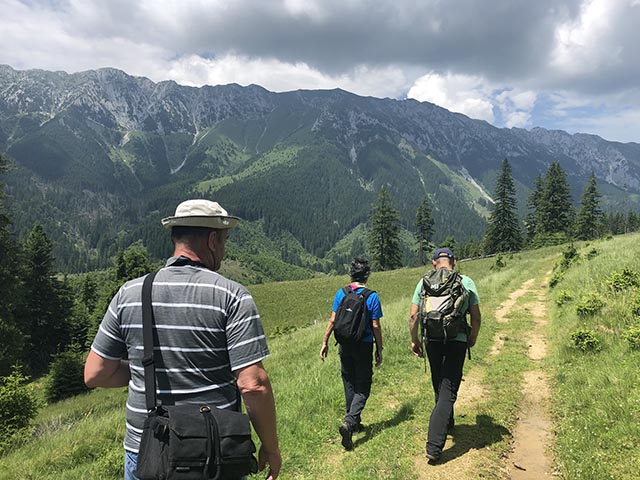
Located on the eastern side of the Southern Carpathians and only a few kilometres from Brasov, Piatra Craiului is a mountain range that stands out from all the other massifs in Romania thanks to its unmistakable rocky and narrow limestone ridge. Hikers will be immediately and almost magically attracted by this distinctive and spectacular appearance on the horizon that can be seen from a distance. The range is also home to one of Romania’s largest and most beautiful natural parks, Piatra Craiului National Park, so there’s rich wildlife biodiversity hidden in its natural landscapes.
Piatra Craiului Mountains are often touted as a top hiking and climbing destination in Romania, featuring a wide variety of hiking, rock climbing spots and mountain bike routes for both seasoned mountaineers and adventurers, as well as beginners or people looking to spend a day out in nature. Hiking trails start from various small villages such as Dambovicioara, Magura, Pestera, Sirnea or Zarnesti and you’ll discover impressive relief forms along the way such as gorges, canyons, and caves.
Some of the most popular hiking day trips in Piatra Craiului start from the town of Zarnesti. One such trail begins at Fantana lui Botorog with gentle slopes taking you through the spectacular Zarnesti Gorges where steep and tall limestone walls will isolate you from the world. The Gorges also make for a great rock-climbing spot but you’ll need to find a guide with proper equipment for this. You will continue all the way to Cheia Pisicii and Valea Vladusca to get amazing views of the area in a hike that can be completed in about 6 hours.
From the same starting point you can go on a more challenging hike up to Curmatura Hut. This trail is a bit steeper with a positive altitude difference of 1,000m while trekking through dense woodlands until reaching Zanoaga plain. This is a great spot to rest and admire the limeston ridge of Piatra Craiului in the distance. Then you’ll continue your journey following the yellow markings to the Curmatura Hut tucked away in the deep pine forests. The whole trip should take around 3-4 hours.
If you want to take on the main ridge of Piatra Craiului mountains and reach its highest point at La Om Peak (2,238m) get ready for an 8-10h trail departing from Pestera village. Due to the length and the intensity of the hike it’s best not to venture without a guide as getting lost, especially as evening comes, can be dangerous. The best way to summit the peak and “ride the ridge” is to stay overnight at Curmatura hut and do a 2-day hiking trip. Once you’ve reached the ridge you’ll enjoy breathtaking views of the area which will be worth the effort.
2. Hiking in Bucegi Mountains
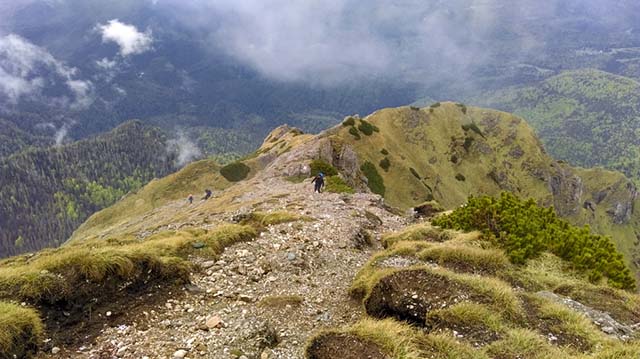
As the easternmost range of the Southern Carpathians, Bucegi Mountains are by far one of the most beloved destinations for hiking and trekking in Romania all year round. For starters, the proximity to Bucharest and Brasov as well as the cable cars from Sinaia and Busteni taking you straight to Bucegi plateau allows for quick and easy access to the massif.
Most hiking trails start from the small towns of Busteni or Sinaia where you can grab the cable car and quickly reach the plateau. Make sure you take waiting times into consideration which can be extremely long on weekends or summer seasons. You can, of course, hike up to the plateau on your own – a 4h relatively easy hike starting from Piatra Arsa Hotel.
There are many wonders that Mother Nature left in these mountains. Add a variety of well-kept hiking trails that are very suitable for beginners and people with an average physical condition, and you can easily see why Bucegi mountains are a favourite among hikers and mountain lovers. Most tourists and easy hikers will want to see the intriguing rock formations Babele and Sphinx and then head off to Caraiman Cross, an impressive monument for WWI soldiers which overlooks Prahova valley from 2,000m altitude.
Experienced hikers will want to see the glacial landforms Morarului Valley, Padina Crucii, Malaiesti, and Tiganesti valleys. From Cabana Babele on the plateau you can take a 4h round-trip trail to Omu Peak, the 7th tallest in Romania at 2,505m altitude following the yellow marked trail.
Since most hikes are beginner-friendly and many of the attractions are located fairly close to one another, you’ll be able to explore more than one trail in a day trip if you’re in good physical shape. You could also consider staying up in the mountains a couple of nights at a cabin and take your time to explore the mountains.
3. Hiking in Fagaras Mountains
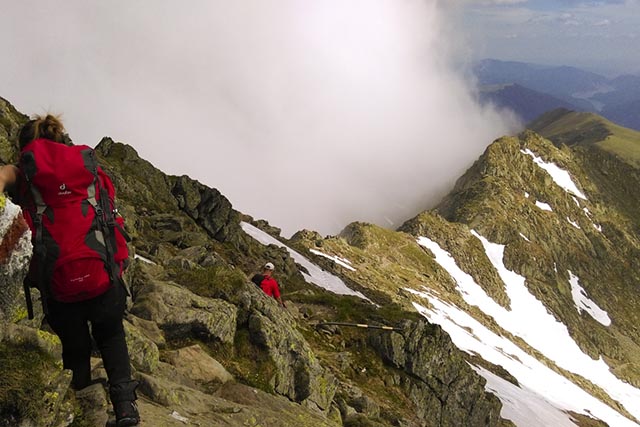
As if a massive rock separates Transylvania from Southern Romania (known as Wallachia) with its peaks spiralling towards the sky, Fagaras Mountains are both the highest mountain range (2544m at Moldoveanu Peak) and one of the coolest hiking destinations in Romania.
Fagaras Mountains, also known as the Transylvanian Alps, are both captivating and dangerous – which make them a perfect challenge for experienced hikers visiting Romania. Their impressive altitude and peaks, breathtaking views, rocky trails going on high-altitude crests (where one wrong step can be fatal!) and completely wild scenery will put your hiking skills and physical condition to the test. So you have to plan your hiking trip carefully and preferably take a hiking guide with you because of the risks involved. Fagaras Mountains are tricky, the weather changes fast and there are few refuges or cabins for hikers going deep in the mountains.
For a one-day trip you can drive on the Transfagarasan Road (only during July – October; outside this period you’ll take a cable car but expect heavy snow and a risk for avalanches) and get to Balea Lake at 2,000m altitude which serves as a starting point for many hiking trails. From there, you can embark on a 5-to-6-hour hike to the main ridge of Fagaras Mountains, passing splendid valleys, sharp ridges, and glacial lakes along the way. It’s an intense hike that requires you to be in proper physical condition, but the breathtaking views you get to enjoy once you’ve reached the top will make it worth the effort.
You can also explore the northern side of Fagaras Mountains and start your journey at Negoiu Chalet on the Serbota summit. There are multiple hiking trails of various lengths and difficulty levels departing from the chalet so you can choose the ones that appeal to you the most when you’re there, also taking into account weather conditions.
If you want to summit the highest peak in Romania, Moldoveanu at 2,544m altitude, you’ll need to plan a 3-day hiking trip. Starting from Balea Lake to Podragu Cabin (6h), and the next day an 8-9h round-trip to the peak and back to the cabin. This trail has a high difficulty level, with some very dangerous sections, so only experienced hikers should consider it, or those going with a guide who can help them.
Know Before You Go…
So there’s no shortage of hiking trails you can do in Romania’s beautiful Carpathian Mountains, and Brasov is definitely a great place to set up a base for that. But we’ve seen two reasons why people planning to go hiking in Romania don’t have an enjoyable experience. The first reason is people underestimate the wilderness of Romania’s mountains – home to the largest brown bear population in Europe and to many other wildlife – which make close encounters very likely. The second is people overestimate the hiking infrastructure, expecting maps, info points, refuges and manned cabins like in other parts of Europe – which is definitely not the case in Romania.
Safety should be the highest priority on a hiking trip so before you venture out on any of these trails make sure you do proper research or consider hiring an experienced hiking guide who can take the burden of planning off your shoulders. Not only will this help you save time, but guides also make for excellent travel companions who can find the best spots, offer accurate information about the places you visit, and deliver a superior hiking experience – while you enjoy your trip and the beautiful views Romania’s Carpathian Mountains offer.
Want to camp in Romania? Read: Wild Camping Laws of Every European Country
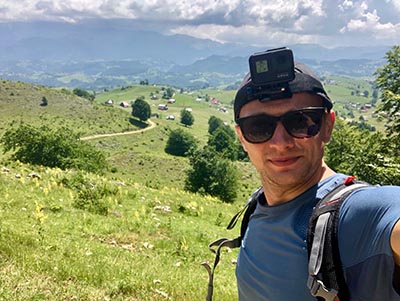
Marius Iliescu is the founder of Romanian Friend: a one-stop shop website with tours, practical info and travel inspiration for those planning to visit Romania. His mission is to make sure travellers experience the best of his country while supporting local communities through responsible and inclusive tourism.


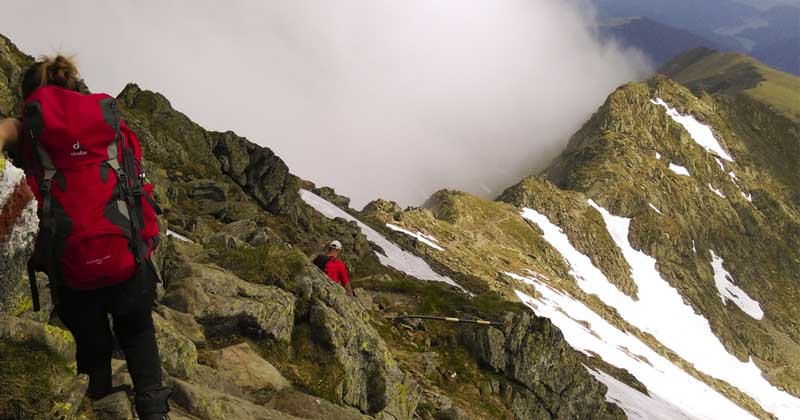

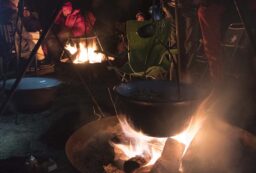
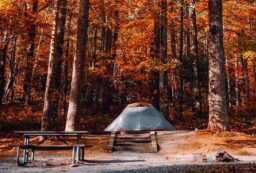







Post your comments